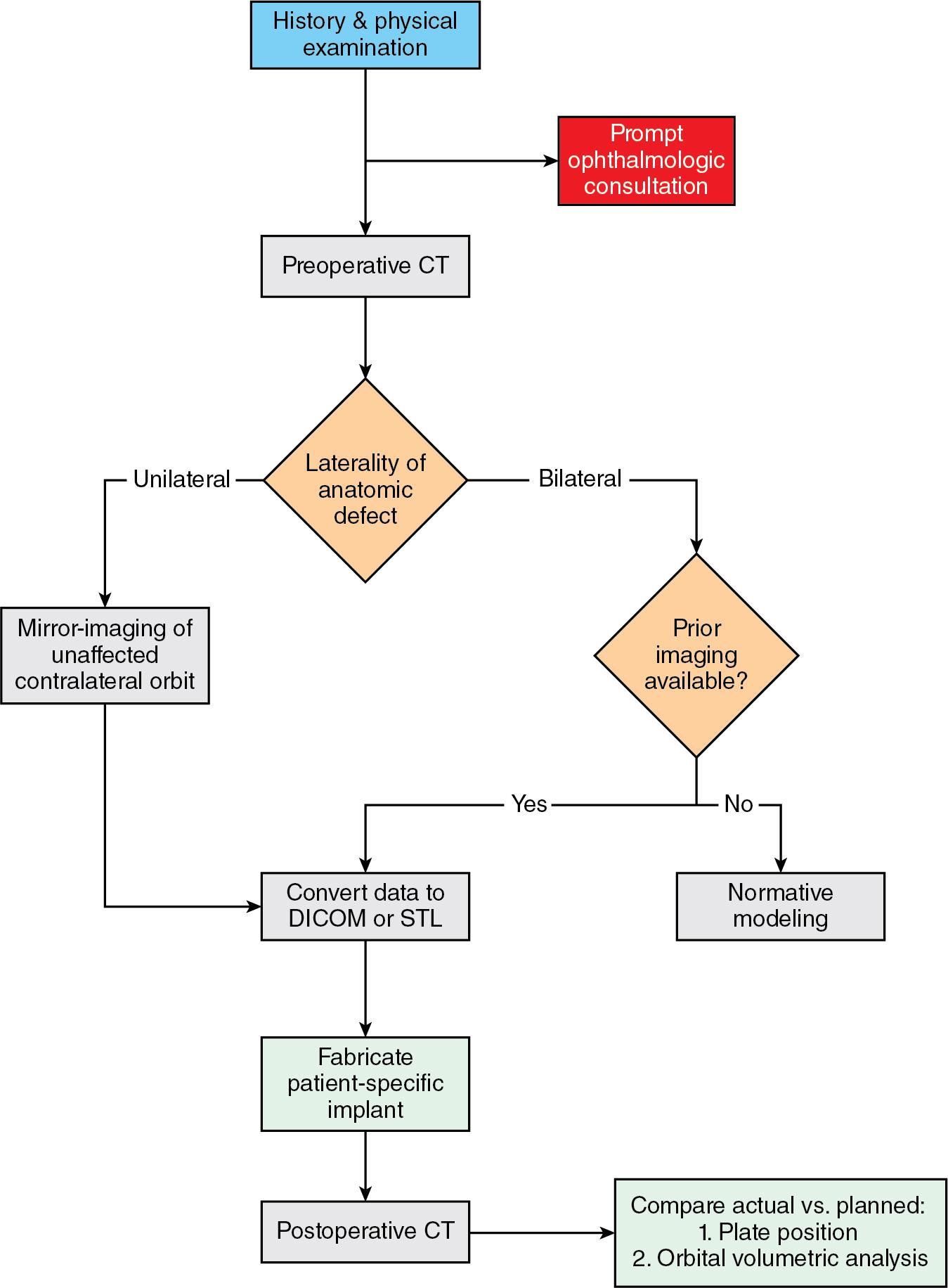Physical Address
304 North Cardinal St.
Dorchester Center, MA 02124
Several indications necessitate posttraumatic orbital reconstruction. For example, restrictive diplopia secondary to entrapment of extraocular muscles can lead to irreversible muscle ischemia and necrosis within hours, thus requiring emergent surgery. In particular, pediatric patients are especially susceptible to extraocular muscle entrapment due to the increased bone elasticity in their orbital floor—resulting in self-reduction as opposed to a fracture. Enophthalmos secondary to orbital herniation or implant displacement can lead to globe malposition and increased orbital volume due to loss of structural support, ultimately necessitating surgery as well. Given the reconstructive complexity of orbital floor repair and the high risk of patient dissatisfaction, there is an essential need for improved accuracy and precision.
Over the past two decades, radiographic advances have allowed not only the introduction of computer-assisted surgical planning (CaSP) but have also created headway for the creation of custom patient-specific implants to cover the orbital defect. This revolutionary technology has improved the accuracy, efficiency, and safety in the surgical management of orbital fractures. Aside from enhanced operative efficacy, these innovations have significantly improved patient outcomes and satisfaction.
Ocular injuries are frequently seen in orbital floor fractures. As such, prompt ophthalmologic consultation is imperative in all suspected cases of orbital fracture to evaluate for ocular trauma. However, when the consultor is initially evaluating the patient, they must be mindful of the relative contraindications that may delay orbital reconstruction, such as hyphema, retinal tear, or lens displacement. Inversely, there are no known absolute contraindications to CaSP.
In this chapter, the authors present their preferred computer-assisted design/computer-assisted manufacturing (CAD/CAM) workflow to perform posttraumatic orbital reconstruction. This methodology has been validated by the senior author (J.L) and thus the chapter will focus on the nuances of this approach and provide information to surgeons who hope to utilize CAD/CAM-based orbital reconstruction.
The first step of assessment for a patient presenting with suspected orbital fracture secondary to trauma is to perform a thorough trauma survey, ensuring the patient’s airway, breathing, and circulation is not compromised. Afterward, the clinical examination should begin with the inspection of the globe and orbit—pecifically examining the enophthalmos, dystopia, periorbital edema and ecchymosis, orbital rim step-off, and subconjunctival hemorrhage. Additionally, comprehensive neurologic and eye examinations are warranted in patients evaluated for posttraumatic orbital repair including assessment of extraocular movements and vision.
During the assessment of extraocular movements, the presence of strabismus can be further differentiated based on restrictive or neurogenic etiology. This is critical because orbital reconstruction is likely to improve restrictive strabismus but unlikely to improve paralytic strabismus. Thus, whenever evaluating an orbital injury a forced duction test must be conducted in order to determine if a patient’s pathology is secondary to a restrictive etiology. Additionally, exophthalmometric measurement of the globe position relative to the lateral orbital rim should be performed to determine abnormally low orbital volume.
Beyond the physical exam, a thorough patient history should be taken. Determining the mechanism of injury, time of injury, ocular complaints, and prior facial trauma or procedures are vital pieces of information. Notably, facial implant utilization should be investigated for any patient with prior facial trauma. Patients who acutely present with an orbital fracture may report symptoms of diplopia, dystopia, periorbital pain, and paresthesia along the infraorbital dermatome. Therefore, understanding the events prior to the onset of these symptoms should be assessed to gain insight into the etiology, severity of damage, and to determine appropriate next steps.
Like most acute trauma evaluations, thin-cut (~1-mm) computed tomography (CT) scan is the first choice for diagnostic radiographic evaluation due to its thorough evaluation of the bony anatomy within the orbit. Magnetic resonance imaging (MRI) can be utilized if the patient has any contraindications to CT imaging. Not only is an up-to-date CT image essential for proper evaluation for orbital reconstruction, but it is also necessary for the manufacturing of patient-specific custom plates. Diagnostic imaging should focus on assessing the orbital volume of the affected eye compared to the uninjured side.
The workflow for CAD/CAM-based orbital reconstruction is presented in ppt 18.1 .

Using CAD has several benefits as it relates to orbital reconstruction. First, CAD offers the intersectionality of three data sources: clinical information, patient photos, and three-dimensional (3D) skeletal imaging. This provides a unique opportunity to see all three datasets work synchronously together and allows the radiographic imaging used in CAD to provide morphometric data, such as the anteroposterior (AP) orbital floor length (approximately 30 mm) and the orbital floor angle (~21 degrees). , Accordingly, it is essential to obtain adequate preoperative multiplanar-view CT images, consisting of axial, coronal, sagittal, and 3D reconstruction.
Secondly, CAD offers auto-segmentation of the unaffected orbit to visualize the preinjured globe. The contralateral segment is then mirrored and repositioned to ensure anatomically accurate repair of the defective side. In cases of bilateral orbital floor fractures, obtaining recent CT imaging would be the most ideal for patient-specific restoration. If unavailable, normative modeling utilizing pooled data as a reference model can generate a normative approximation. In all these cases, CAD ultimately facilitates the ability to customize patient-specific implants, facilitate 3D visualization intraoperatively, and provide real-time spatial measurements allowing the surgeon to understand their distance from critical anatomic landmarks—such as the posterior ledge of the orbit.
Postoperatively, CAD also has immense utility. It can quantify the magnitude of fracture reduction, plate position, and volume restoration. An overview of various CAD tools applicable to orbital floor reconstruction can be seen in ppt 18.2 .

Become a Clinical Tree membership for Full access and enjoy Unlimited articles
If you are a member. Log in here